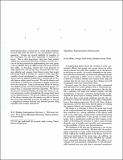Por favor, use este identificador para citar o enlazar a este item:
http://hdl.handle.net/10261/117086COMPARTIR / EXPORTAR:
 SHARE
BASE SHARE
BASE
|
|
| Visualizar otros formatos: MARC | Dublin Core | RDF | ORE | MODS | METS | DIDL | DATACITE | |

| Título: | Distinguishing topical and social groups based on common identity and bond theory |
Autor: | Grabowicz, Przemyslaw CSIC; Aiello, Luca Maria; Eguíluz, Víctor M. CSIC ORCID ; Jaimes, Alejandro | Palabras clave: | Groups Social Media Bond theory Flick Identity theory |
Fecha de publicación: | 2013 | Editor: | Association for Computing Machinery | Citación: | WSDM'13. Proceedings of the Sixth ACM International Conference on Web Search and Data Mining: 627- 636 (2013) | Resumen: | Social groups play a crucial role in social media platforms because they form the basis for user participation and engagement. Groups are created explicitly by members of the community, but also form organically as members interact. Due to their importance, they have been studied widely (e.g., community detection, evolution, activity, etc.). One of the key questions for understanding how such groups evolve is whether there are different types of groups and how they differ. In Sociology, theories have been proposed to help explain how such groups form. In particular, the common identity and common bond theory states that people join groups based on identity (i.e., interest in the topics discussed) or bond attachment (i.e., social relationships). The theory has been applied qualitatively to small groups to classify them as either topical or social. We use the identity and bond theory to define a set of features to classify groups into those two categories. Using a dataset from Flickr, we extract user-defined groups and automatically-detected groups, obtained from a community detection algorithm. We discuss the process of manual labeling of groups into social or topical and present results of predicting the group label based on the defined features. We directly validate the predictions of the theory showing that the metrics are able to forecast the group type with high accuracy. In addition, we present a comparison between declared and detected groups along topicality and sociality dimensions. | Descripción: | arXiv:1309.2199 | Versión del editor: | http://dx.doi.org/10.1145/2433396.2433475 | URI: | http://hdl.handle.net/10261/117086 | DOI: | 10.1145/2433396.2433475 | Identificadores: | doi: 10.1145/2433396.2433475 |
| Aparece en las colecciones: | (IFISC) Libros y partes de libros |
Ficheros en este ítem:
| Fichero | Descripción | Tamaño | Formato | |
|---|---|---|---|---|
| distinguishing_topical_social_groups_Grabowicz.pdf | 660,89 kB | Adobe PDF |  Visualizar/Abrir |
CORE Recommender
Page view(s)
271
checked on 23-abr-2024
Download(s)
420
checked on 23-abr-2024
Google ScholarTM
Check
Altmetric
Altmetric
NOTA: Los ítems de Digital.CSIC están protegidos por copyright, con todos los derechos reservados, a menos que se indique lo contrario.
